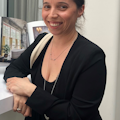It’s all about the upbringing.
From her childhood on the coast of Corpus Christi, Texas to her days as a practicing architect on the San Francisco Bay, Doris Guerrero, founder of dform: architecture, interiors, landscape, was ingrained with a holistic outlook on life that’s she’s been able to repurpose repeatedly.
“I don’t see a difference between work and home—and that’s not to say that I work at home all the time or that I work 24/7. But I feel the same compassion and excitement we have about our personal lives should be extended to our work. We should approach our personal lives creatively as well. My training as an architect and designer has been a really great training for my life,” she says.
It’s because of this mindset that Guerrero has looked towards allied fields of design and other facets of life in her practice, more so than many of her colleagues typically do. As a professor at the Academy of Art University in the interior architecture and design department, she encourages her students to do the same while developing their thesis projects.
She specifically names cinema and production design, as well as fashion, as points of inspiration. “Even from undergrad all the way through to my practice now, I have referenced production design in film countless times, particularly that of David Lynch, David Cronenberg and Peter Greenaway.”
She was only 12 when she started watching Style with Elsa Klensch, a CNN program exploring fashion and design from around the world. “Designers like Claude Montana, Alexander McQueen, Jean Paul Gaultier, Betsey Johnson—these were designers that I grew up with that were in when I was taking art classes in high school and junior high,” she explains.
Guerrero attended college at the University of Texas at Austin before moving to San Francisco to launch her career and earn her architectural license. After practicing for 12 years at highly respected firms such as landscape designers Hargreaves Associates, she sought out her graduate degree at UCLA, as she wanted to study digital design and urban theory. But that all changed when she attended a consortium on material and atmosphere.
“I was really intrigued by that,” Guerrero recalls. “I had thought I was more interested in urbanism, which I am, but decided that this was really what I wanted to be about. And that was a consortium that I was able to do research and present papers on, and collaborate with colleagues from other UC systems such as fine arts and art history on.”
While still in graduate school, she selected an advanced studio that allowed her to explore the topic of atmosphere and materiality further, prompting her to design a case-study Hollywood Hills home for an industry personality. The project, entitled “Let Them Eat Cake,” is an important aspect of how she teaches today, as it focused on embellishment and ornamentation, as well as the digital and technological aspects of projects and how designers and architects are able to engage in patterning and material use in a way they couldn’t before. It’s a theory and practice she tries to get across to her students on a regular basis.
“A thesis doesn’t have to be flashy,” she tells them. “A thesis should really be about new uses of materials and creating new environments and experiences; understanding technology and new materials and how to appropriately design with them.”
As a kick-off to her thesis development classes, Guerrero takes students to the Academy library, which offers a wide array of publications. “I require students to go to the library with me and I point out not just the interior design publications, which are fantastic, but I also point out others like Art News and Wallpaper, and graphic design and industrial design publications.”
She also pushes them to peruse fashion magazines, academic publications such as the Princeton Review, and magazines published in Italy, as many are developed in Milan where trends are happening. “Often architecture and interior architecture are the last disciplines to integrate trends, so I always suggest to thesis students who are doing projective work to reference publications outside of our field,” Guerrero says.
Contact Information
Doris Guerrero
Founder, dform
Professor, Academy of Art University
Fun fact
Guerrero met her husband while he was in the Air Force, which took them to New Orleans for a couple of years where she continued to work and teach. He is currently going to school for crime scene investigation (CSI).
dform: architecture, interiors,
landscape
(415) 572-4045
[email protected]
Another source of inspiration for her are the Academy students themselves. “I feel an affinity towards them because they are from a really diverse range of backgrounds and places,” she says, with some just starting out, others who’ve been practicing for years, some who are on the other side of the world and others who are just returning to the classroom after having children. “They really want to be there. I’m more engaged, because they are so dedicated. It doesn’t really feel like a job.”
With no barriers between work and play—as Guerrero practices and preaches—work becomes play. It’s not a luxury for everyone, but it is there for the taking by creative people. And more importantly, it allows one to see the beauty and value in all their surroundings.
About the Author
AnnMarie Martin
Editor-in-Chief
AnnMarie is the former Editor in Chief of i+s and has been covering the commercial design space. Her style and vision has helped the brand evolve into a thought leader in purpose-driven design and cultural movements shaping the way we live and work.

